Human Factors in Machine Systems: An Analysis of VR Gaming Systems
VerifiedAdded on 2023/01/11
|14
|4050
|71
Report
AI Summary
This report examines the human factors involved in virtual reality (VR) gaming systems. It begins by introducing advanced VR play systems and their components, such as OLED screens and motion controllers. The report then delves into the visual sensory system, discussing light as a stimulus, visual processing, and limitations, including depth perception through bottom-up and top-down processing. It also covers visual search strategies. Furthermore, the report explores the auditory, tactile, and vestibular systems, examining sound levels, reduction in sound intensity, and the role of the tactile and haptic systems. The report also discusses proprioception, kinetics, and the cognitive aspects of VR gaming, including top-down and bottom-up processing, working memory limitations, long-term memory, and selected and divided attention. The analysis helps to understand how human perception, cognition, and sensory systems interact within VR environments, offering insights into user experience and system design.

Running Head: HUMAN FACTOR 0
Human facor in machine system
[Document subtitle]
[DATE]
[Company address]
Human facor in machine system
[Document subtitle]
[DATE]
[Company address]
Paraphrase This Document
Need a fresh take? Get an instant paraphrase of this document with our AI Paraphraser

HUMAN FACTOR 1
Table of Contents
Advanced VR play systems...................................................................................................................2
The visual sensory system.....................................................................................................................2
Visual sensory processing and limitation...........................................................................................3
Depth perception...............................................................................................................................3
Bottom-up..........................................................................................................................................3
Tap down...........................................................................................................................................4
Visual search.....................................................................................................................................4
Auditory, tactile and vestibular system..................................................................................................5
Sound level and time of exposure......................................................................................................5
Reduction in sound intensity..............................................................................................................6
Tactile and haptic system...................................................................................................................6
Proprioception and kinetics...............................................................................................................7
Cognition...............................................................................................................................................8
Top-down and bottom-up processing................................................................................................9
Working Memory Limitations...........................................................................................................9
Long-term memory..........................................................................................................................10
Selected and divided attention.........................................................................................................10
References...........................................................................................................................................11
Table of Contents
Advanced VR play systems...................................................................................................................2
The visual sensory system.....................................................................................................................2
Visual sensory processing and limitation...........................................................................................3
Depth perception...............................................................................................................................3
Bottom-up..........................................................................................................................................3
Tap down...........................................................................................................................................4
Visual search.....................................................................................................................................4
Auditory, tactile and vestibular system..................................................................................................5
Sound level and time of exposure......................................................................................................5
Reduction in sound intensity..............................................................................................................6
Tactile and haptic system...................................................................................................................6
Proprioception and kinetics...............................................................................................................7
Cognition...............................................................................................................................................8
Top-down and bottom-up processing................................................................................................9
Working Memory Limitations...........................................................................................................9
Long-term memory..........................................................................................................................10
Selected and divided attention.........................................................................................................10
References...........................................................................................................................................11
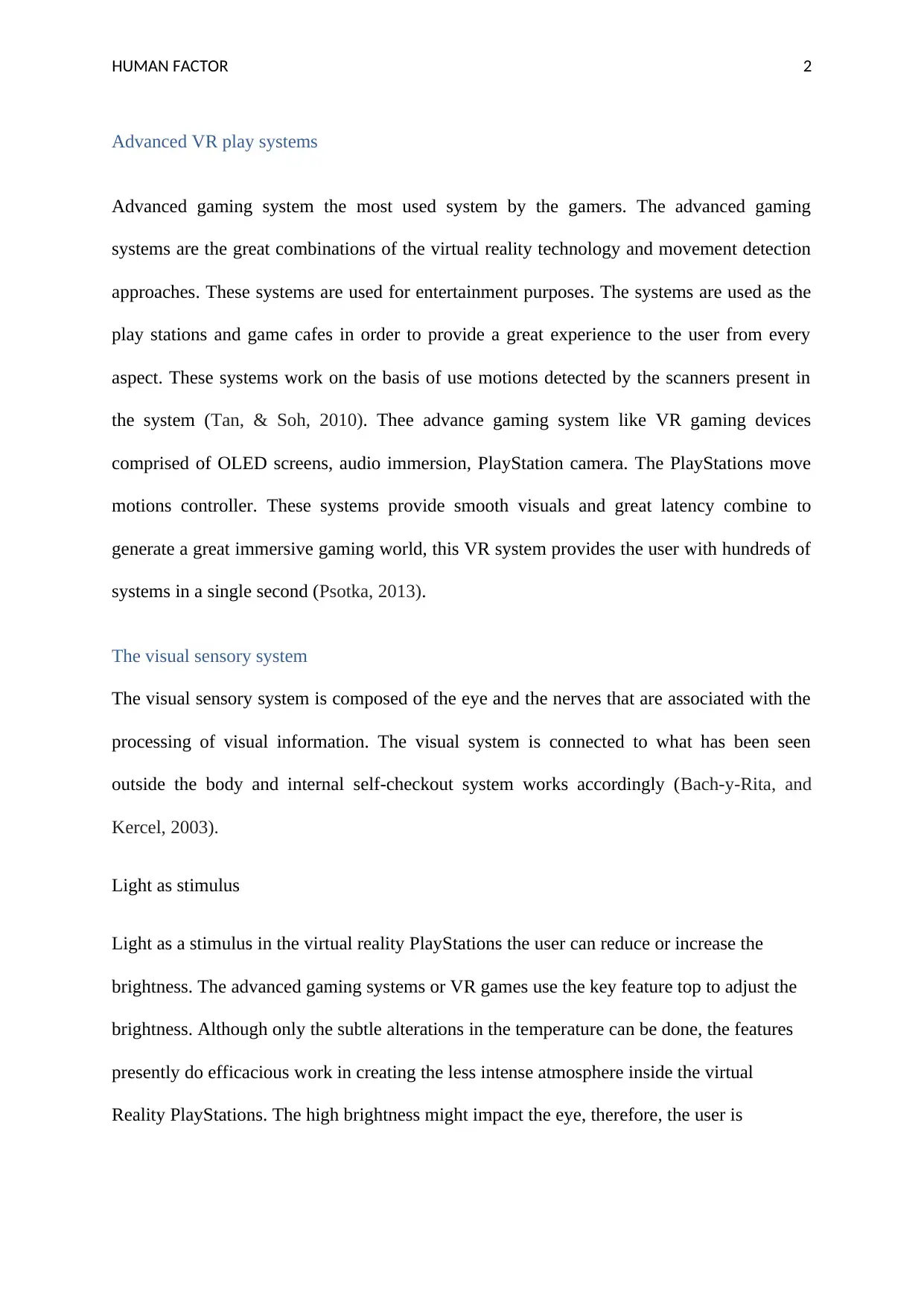
HUMAN FACTOR 2
Advanced VR play systems
Advanced gaming system the most used system by the gamers. The advanced gaming
systems are the great combinations of the virtual reality technology and movement detection
approaches. These systems are used for entertainment purposes. The systems are used as the
play stations and game cafes in order to provide a great experience to the user from every
aspect. These systems work on the basis of use motions detected by the scanners present in
the system (Tan, & Soh, 2010). Thee advance gaming system like VR gaming devices
comprised of OLED screens, audio immersion, PlayStation camera. The PlayStations move
motions controller. These systems provide smooth visuals and great latency combine to
generate a great immersive gaming world, this VR system provides the user with hundreds of
systems in a single second (Psotka, 2013).
The visual sensory system
The visual sensory system is composed of the eye and the nerves that are associated with the
processing of visual information. The visual system is connected to what has been seen
outside the body and internal self-checkout system works accordingly (Bach-y-Rita, and
Kercel, 2003).
Light as stimulus
Light as a stimulus in the virtual reality PlayStations the user can reduce or increase the
brightness. The advanced gaming systems or VR games use the key feature top to adjust the
brightness. Although only the subtle alterations in the temperature can be done, the features
presently do efficacious work in creating the less intense atmosphere inside the virtual
Reality PlayStations. The high brightness might impact the eye, therefore, the user is
Advanced VR play systems
Advanced gaming system the most used system by the gamers. The advanced gaming
systems are the great combinations of the virtual reality technology and movement detection
approaches. These systems are used for entertainment purposes. The systems are used as the
play stations and game cafes in order to provide a great experience to the user from every
aspect. These systems work on the basis of use motions detected by the scanners present in
the system (Tan, & Soh, 2010). Thee advance gaming system like VR gaming devices
comprised of OLED screens, audio immersion, PlayStation camera. The PlayStations move
motions controller. These systems provide smooth visuals and great latency combine to
generate a great immersive gaming world, this VR system provides the user with hundreds of
systems in a single second (Psotka, 2013).
The visual sensory system
The visual sensory system is composed of the eye and the nerves that are associated with the
processing of visual information. The visual system is connected to what has been seen
outside the body and internal self-checkout system works accordingly (Bach-y-Rita, and
Kercel, 2003).
Light as stimulus
Light as a stimulus in the virtual reality PlayStations the user can reduce or increase the
brightness. The advanced gaming systems or VR games use the key feature top to adjust the
brightness. Although only the subtle alterations in the temperature can be done, the features
presently do efficacious work in creating the less intense atmosphere inside the virtual
Reality PlayStations. The high brightness might impact the eye, therefore, the user is
⊘ This is a preview!⊘
Do you want full access?
Subscribe today to unlock all pages.

Trusted by 1+ million students worldwide

HUMAN FACTOR 3
recommended to use this system according to their comfort level (Latham, Patston, &
Tippett, 2013).
Visual sensory processing and limitation
The visual system is the part of the body's central nervous system. The system enables a
person to see and process visual information. The major cell in the visual sensory processing
is named a photoreceptor (Vroomen et al, 2004).
In the virtual system the screen is fixed on the head of the user and the direction or angle and
at the little height can be adjusted. This put up a wide range of possible clients. Because the
VR play system is aimed to be applied by as numerous individuals as conceivable, it has had
certain deliberations in its project for all type of people. The humanoid eye observes a picture
by partaking the electromagnetic radiation of light transports by the cornea towards the front
of the human eye, throughout the lens behindhand the iris, and lastly placed on the retina at
the backside of the eye (Rees, Frith, and Lavie, 2001)
Both near and the far-sightedness considered as most common and very dissimilar from each
other described by the vision conditions. In Colour blindness which is basically not the type
of blindness, nonetheless, a lack or impairment of vision sensory processing, and the patient
is unable to distinguish between some colours (Bach-y-Rita, and Kercel, 2003).
Depth perception
Bottom-up
Bottom-up handling is the component of handling which openly depends on outside stimuli.
Binocular cues denote to the depth signals in which both human eyes are obligatory to
observe. Convergence denotes to the point that the nearer a thing, the additional inward
human eyes require to turn in order to concentrate (Rookes, and Willson, 2005).
recommended to use this system according to their comfort level (Latham, Patston, &
Tippett, 2013).
Visual sensory processing and limitation
The visual system is the part of the body's central nervous system. The system enables a
person to see and process visual information. The major cell in the visual sensory processing
is named a photoreceptor (Vroomen et al, 2004).
In the virtual system the screen is fixed on the head of the user and the direction or angle and
at the little height can be adjusted. This put up a wide range of possible clients. Because the
VR play system is aimed to be applied by as numerous individuals as conceivable, it has had
certain deliberations in its project for all type of people. The humanoid eye observes a picture
by partaking the electromagnetic radiation of light transports by the cornea towards the front
of the human eye, throughout the lens behindhand the iris, and lastly placed on the retina at
the backside of the eye (Rees, Frith, and Lavie, 2001)
Both near and the far-sightedness considered as most common and very dissimilar from each
other described by the vision conditions. In Colour blindness which is basically not the type
of blindness, nonetheless, a lack or impairment of vision sensory processing, and the patient
is unable to distinguish between some colours (Bach-y-Rita, and Kercel, 2003).
Depth perception
Bottom-up
Bottom-up handling is the component of handling which openly depends on outside stimuli.
Binocular cues denote to the depth signals in which both human eyes are obligatory to
observe. Convergence denotes to the point that the nearer a thing, the additional inward
human eyes require to turn in order to concentrate (Rookes, and Willson, 2005).
Paraphrase This Document
Need a fresh take? Get an instant paraphrase of this document with our AI Paraphraser
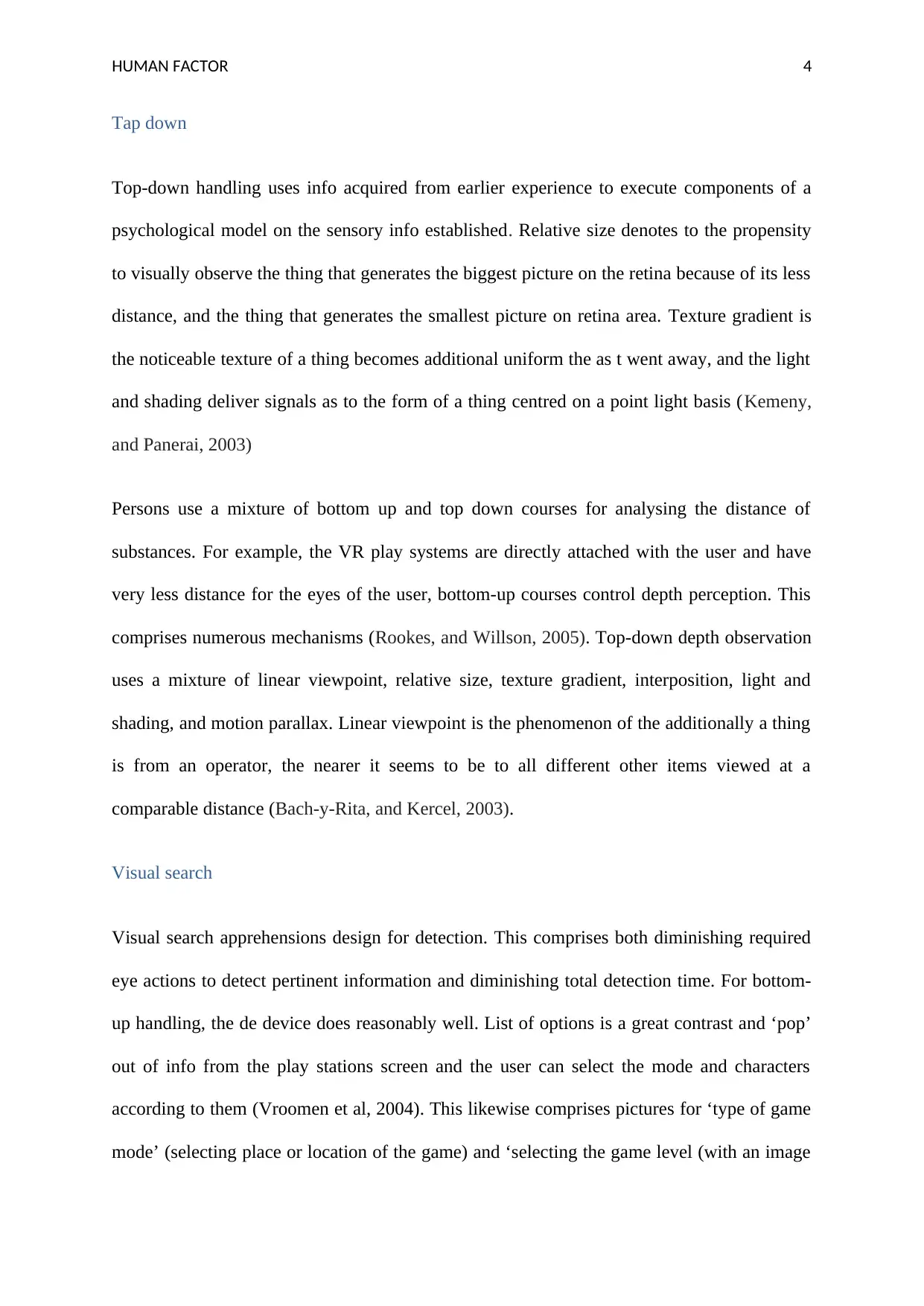
HUMAN FACTOR 4
Tap down
Top-down handling uses info acquired from earlier experience to execute components of a
psychological model on the sensory info established. Relative size denotes to the propensity
to visually observe the thing that generates the biggest picture on the retina because of its less
distance, and the thing that generates the smallest picture on retina area. Texture gradient is
the noticeable texture of a thing becomes additional uniform the as t went away, and the light
and shading deliver signals as to the form of a thing centred on a point light basis (Kemeny,
and Panerai, 2003)
Persons use a mixture of bottom up and top down courses for analysing the distance of
substances. For example, the VR play systems are directly attached with the user and have
very less distance for the eyes of the user, bottom-up courses control depth perception. This
comprises numerous mechanisms (Rookes, and Willson, 2005). Top-down depth observation
uses a mixture of linear viewpoint, relative size, texture gradient, interposition, light and
shading, and motion parallax. Linear viewpoint is the phenomenon of the additionally a thing
is from an operator, the nearer it seems to be to all different other items viewed at a
comparable distance (Bach-y-Rita, and Kercel, 2003).
Visual search
Visual search apprehensions design for detection. This comprises both diminishing required
eye actions to detect pertinent information and diminishing total detection time. For bottom-
up handling, the de device does reasonably well. List of options is a great contrast and ‘pop’
out of info from the play stations screen and the user can select the mode and characters
according to them (Vroomen et al, 2004). This likewise comprises pictures for ‘type of game
mode’ (selecting place or location of the game) and ‘selecting the game level (with an image
Tap down
Top-down handling uses info acquired from earlier experience to execute components of a
psychological model on the sensory info established. Relative size denotes to the propensity
to visually observe the thing that generates the biggest picture on the retina because of its less
distance, and the thing that generates the smallest picture on retina area. Texture gradient is
the noticeable texture of a thing becomes additional uniform the as t went away, and the light
and shading deliver signals as to the form of a thing centred on a point light basis (Kemeny,
and Panerai, 2003)
Persons use a mixture of bottom up and top down courses for analysing the distance of
substances. For example, the VR play systems are directly attached with the user and have
very less distance for the eyes of the user, bottom-up courses control depth perception. This
comprises numerous mechanisms (Rookes, and Willson, 2005). Top-down depth observation
uses a mixture of linear viewpoint, relative size, texture gradient, interposition, light and
shading, and motion parallax. Linear viewpoint is the phenomenon of the additionally a thing
is from an operator, the nearer it seems to be to all different other items viewed at a
comparable distance (Bach-y-Rita, and Kercel, 2003).
Visual search
Visual search apprehensions design for detection. This comprises both diminishing required
eye actions to detect pertinent information and diminishing total detection time. For bottom-
up handling, the de device does reasonably well. List of options is a great contrast and ‘pop’
out of info from the play stations screen and the user can select the mode and characters
according to them (Vroomen et al, 2004). This likewise comprises pictures for ‘type of game
mode’ (selecting place or location of the game) and ‘selecting the game level (with an image

HUMAN FACTOR 5
of fight mode). The device also comprises a control 3D screen that provides the user with
experience of real situations. It likewise has a method for the assistant, to an indication that
the operator is in the requirement of help. Top-down handling concerns probabilities. An
operator of the VR play system requires recognizing that the user has selected the options
before starting the game. It should also have some features like 360 views of the scene and
rapid motions detections techniques. The user can search for their likely characters only y
viewing the screen and select them with the help of the controller. The user commonly
searches for the characters that are strong and with different abilities and skills (Rees, Frith,
and Lavie, 2001).
The auditory, tactile and vestibular system
To interact with the system humans also needs to use their auditory, tactile and vestibular
type of systems. The auditory system alarms the ear, the tactile structure alarms the sense of
touch, and lastly, the vestibular system deals with the balance. Similarly, VR play systems
can be moved and portable. The systems are not very big therefore can be carried from one
place to another (Su, & Parham, 2014).
Sound level and time of exposure
In the VR pay system is the most promising system in the advanced game systems. This
includes the home and to the big plays stations setups. The game allows the user a great
experience and the users might play for hours continuously. This exposes various sources of
the different type of noise sources. The humanoid ears hear the sound frequencies range from
twenty Hz to twenty kHz, this refers to the ability of ears to hear the sound. For a human to
distinguish the main or important sound to hear it is essential that the sound should be higher
than the other types of noises occurs in the area or background (Gentile, Swing, Lim, &
Khoo, 2012). For example, the game system provides the 3 d sound effects top to provide the
of fight mode). The device also comprises a control 3D screen that provides the user with
experience of real situations. It likewise has a method for the assistant, to an indication that
the operator is in the requirement of help. Top-down handling concerns probabilities. An
operator of the VR play system requires recognizing that the user has selected the options
before starting the game. It should also have some features like 360 views of the scene and
rapid motions detections techniques. The user can search for their likely characters only y
viewing the screen and select them with the help of the controller. The user commonly
searches for the characters that are strong and with different abilities and skills (Rees, Frith,
and Lavie, 2001).
The auditory, tactile and vestibular system
To interact with the system humans also needs to use their auditory, tactile and vestibular
type of systems. The auditory system alarms the ear, the tactile structure alarms the sense of
touch, and lastly, the vestibular system deals with the balance. Similarly, VR play systems
can be moved and portable. The systems are not very big therefore can be carried from one
place to another (Su, & Parham, 2014).
Sound level and time of exposure
In the VR pay system is the most promising system in the advanced game systems. This
includes the home and to the big plays stations setups. The game allows the user a great
experience and the users might play for hours continuously. This exposes various sources of
the different type of noise sources. The humanoid ears hear the sound frequencies range from
twenty Hz to twenty kHz, this refers to the ability of ears to hear the sound. For a human to
distinguish the main or important sound to hear it is essential that the sound should be higher
than the other types of noises occurs in the area or background (Gentile, Swing, Lim, &
Khoo, 2012). For example, the game system provides the 3 d sound effects top to provide the
⊘ This is a preview!⊘
Do you want full access?
Subscribe today to unlock all pages.

Trusted by 1+ million students worldwide
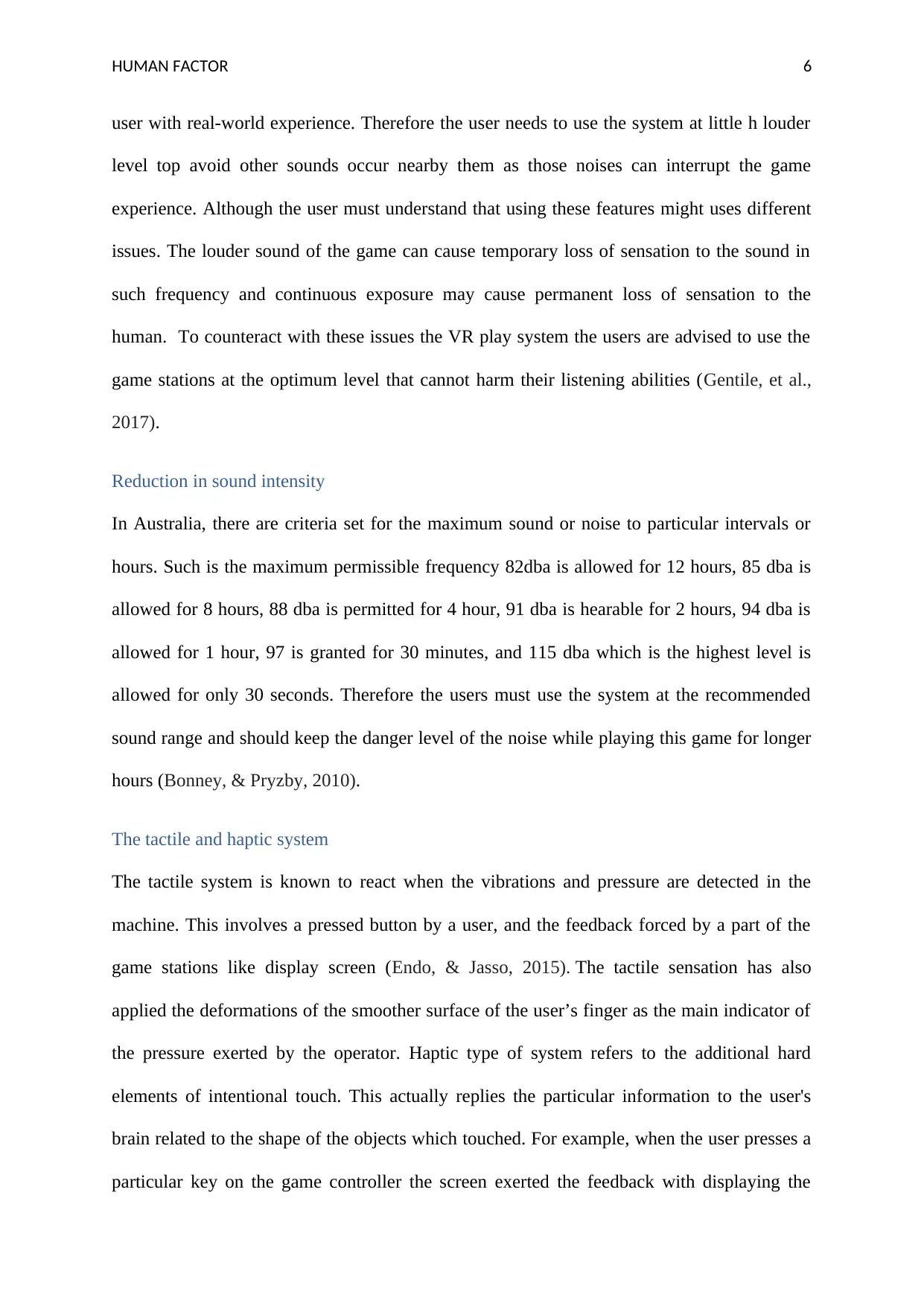
HUMAN FACTOR 6
user with real-world experience. Therefore the user needs to use the system at little h louder
level top avoid other sounds occur nearby them as those noises can interrupt the game
experience. Although the user must understand that using these features might uses different
issues. The louder sound of the game can cause temporary loss of sensation to the sound in
such frequency and continuous exposure may cause permanent loss of sensation to the
human. To counteract with these issues the VR play system the users are advised to use the
game stations at the optimum level that cannot harm their listening abilities (Gentile, et al.,
2017).
Reduction in sound intensity
In Australia, there are criteria set for the maximum sound or noise to particular intervals or
hours. Such is the maximum permissible frequency 82dba is allowed for 12 hours, 85 dba is
allowed for 8 hours, 88 dba is permitted for 4 hour, 91 dba is hearable for 2 hours, 94 dba is
allowed for 1 hour, 97 is granted for 30 minutes, and 115 dba which is the highest level is
allowed for only 30 seconds. Therefore the users must use the system at the recommended
sound range and should keep the danger level of the noise while playing this game for longer
hours (Bonney, & Pryzby, 2010).
The tactile and haptic system
The tactile system is known to react when the vibrations and pressure are detected in the
machine. This involves a pressed button by a user, and the feedback forced by a part of the
game stations like display screen (Endo, & Jasso, 2015). The tactile sensation has also
applied the deformations of the smoother surface of the user’s finger as the main indicator of
the pressure exerted by the operator. Haptic type of system refers to the additional hard
elements of intentional touch. This actually replies the particular information to the user's
brain related to the shape of the objects which touched. For example, when the user presses a
particular key on the game controller the screen exerted the feedback with displaying the
user with real-world experience. Therefore the user needs to use the system at little h louder
level top avoid other sounds occur nearby them as those noises can interrupt the game
experience. Although the user must understand that using these features might uses different
issues. The louder sound of the game can cause temporary loss of sensation to the sound in
such frequency and continuous exposure may cause permanent loss of sensation to the
human. To counteract with these issues the VR play system the users are advised to use the
game stations at the optimum level that cannot harm their listening abilities (Gentile, et al.,
2017).
Reduction in sound intensity
In Australia, there are criteria set for the maximum sound or noise to particular intervals or
hours. Such is the maximum permissible frequency 82dba is allowed for 12 hours, 85 dba is
allowed for 8 hours, 88 dba is permitted for 4 hour, 91 dba is hearable for 2 hours, 94 dba is
allowed for 1 hour, 97 is granted for 30 minutes, and 115 dba which is the highest level is
allowed for only 30 seconds. Therefore the users must use the system at the recommended
sound range and should keep the danger level of the noise while playing this game for longer
hours (Bonney, & Pryzby, 2010).
The tactile and haptic system
The tactile system is known to react when the vibrations and pressure are detected in the
machine. This involves a pressed button by a user, and the feedback forced by a part of the
game stations like display screen (Endo, & Jasso, 2015). The tactile sensation has also
applied the deformations of the smoother surface of the user’s finger as the main indicator of
the pressure exerted by the operator. Haptic type of system refers to the additional hard
elements of intentional touch. This actually replies the particular information to the user's
brain related to the shape of the objects which touched. For example, when the user presses a
particular key on the game controller the screen exerted the feedback with displaying the
Paraphrase This Document
Need a fresh take? Get an instant paraphrase of this document with our AI Paraphraser
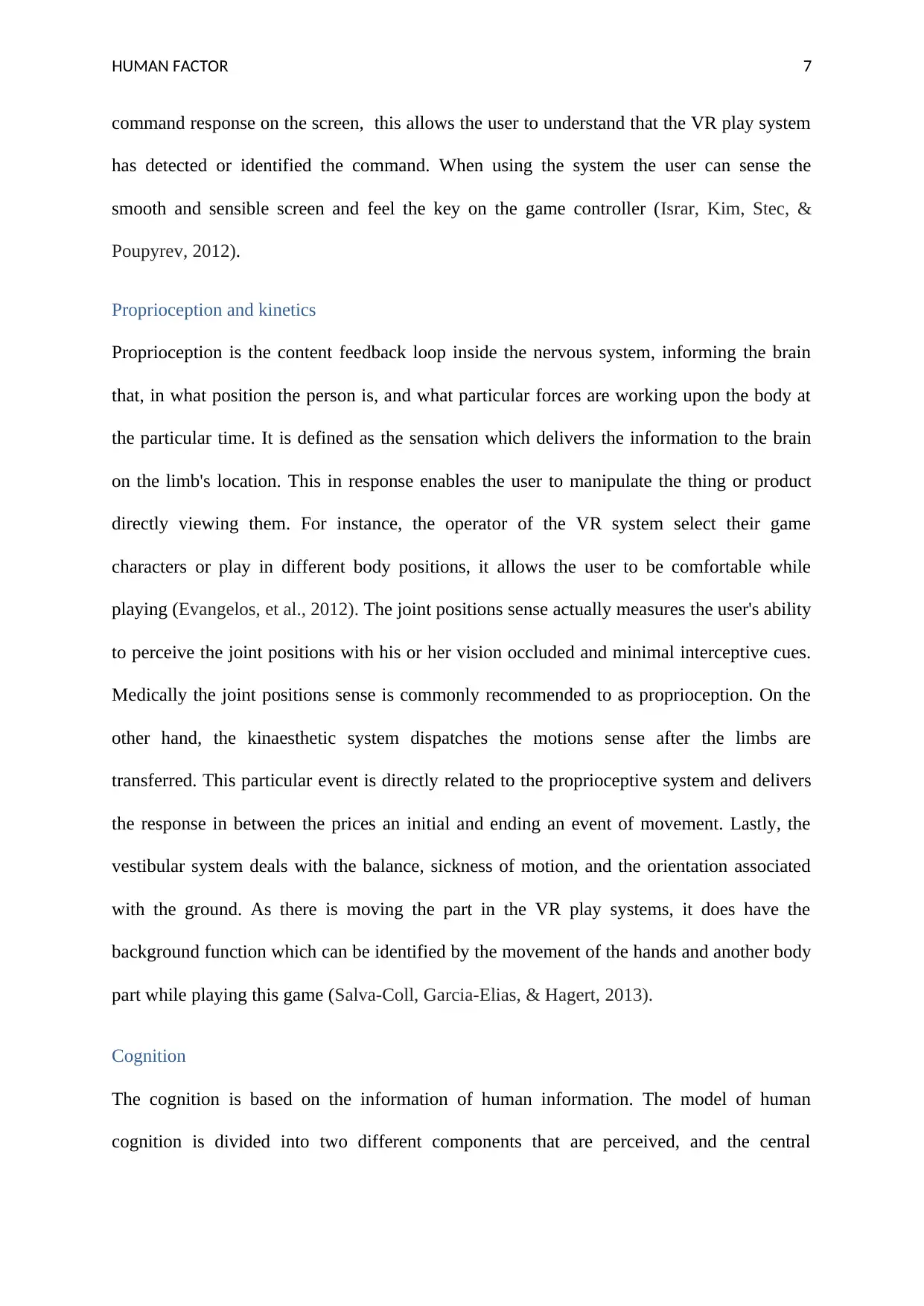
HUMAN FACTOR 7
command response on the screen, this allows the user to understand that the VR play system
has detected or identified the command. When using the system the user can sense the
smooth and sensible screen and feel the key on the game controller (Israr, Kim, Stec, &
Poupyrev, 2012).
Proprioception and kinetics
Proprioception is the content feedback loop inside the nervous system, informing the brain
that, in what position the person is, and what particular forces are working upon the body at
the particular time. It is defined as the sensation which delivers the information to the brain
on the limb's location. This in response enables the user to manipulate the thing or product
directly viewing them. For instance, the operator of the VR system select their game
characters or play in different body positions, it allows the user to be comfortable while
playing (Evangelos, et al., 2012). The joint positions sense actually measures the user's ability
to perceive the joint positions with his or her vision occluded and minimal interceptive cues.
Medically the joint positions sense is commonly recommended to as proprioception. On the
other hand, the kinaesthetic system dispatches the motions sense after the limbs are
transferred. This particular event is directly related to the proprioceptive system and delivers
the response in between the prices an initial and ending an event of movement. Lastly, the
vestibular system deals with the balance, sickness of motion, and the orientation associated
with the ground. As there is moving the part in the VR play systems, it does have the
background function which can be identified by the movement of the hands and another body
part while playing this game (Salva-Coll, Garcia-Elias, & Hagert, 2013).
Cognition
The cognition is based on the information of human information. The model of human
cognition is divided into two different components that are perceived, and the central
command response on the screen, this allows the user to understand that the VR play system
has detected or identified the command. When using the system the user can sense the
smooth and sensible screen and feel the key on the game controller (Israr, Kim, Stec, &
Poupyrev, 2012).
Proprioception and kinetics
Proprioception is the content feedback loop inside the nervous system, informing the brain
that, in what position the person is, and what particular forces are working upon the body at
the particular time. It is defined as the sensation which delivers the information to the brain
on the limb's location. This in response enables the user to manipulate the thing or product
directly viewing them. For instance, the operator of the VR system select their game
characters or play in different body positions, it allows the user to be comfortable while
playing (Evangelos, et al., 2012). The joint positions sense actually measures the user's ability
to perceive the joint positions with his or her vision occluded and minimal interceptive cues.
Medically the joint positions sense is commonly recommended to as proprioception. On the
other hand, the kinaesthetic system dispatches the motions sense after the limbs are
transferred. This particular event is directly related to the proprioceptive system and delivers
the response in between the prices an initial and ending an event of movement. Lastly, the
vestibular system deals with the balance, sickness of motion, and the orientation associated
with the ground. As there is moving the part in the VR play systems, it does have the
background function which can be identified by the movement of the hands and another body
part while playing this game (Salva-Coll, Garcia-Elias, & Hagert, 2013).
Cognition
The cognition is based on the information of human information. The model of human
cognition is divided into two different components that are perceived, and the central
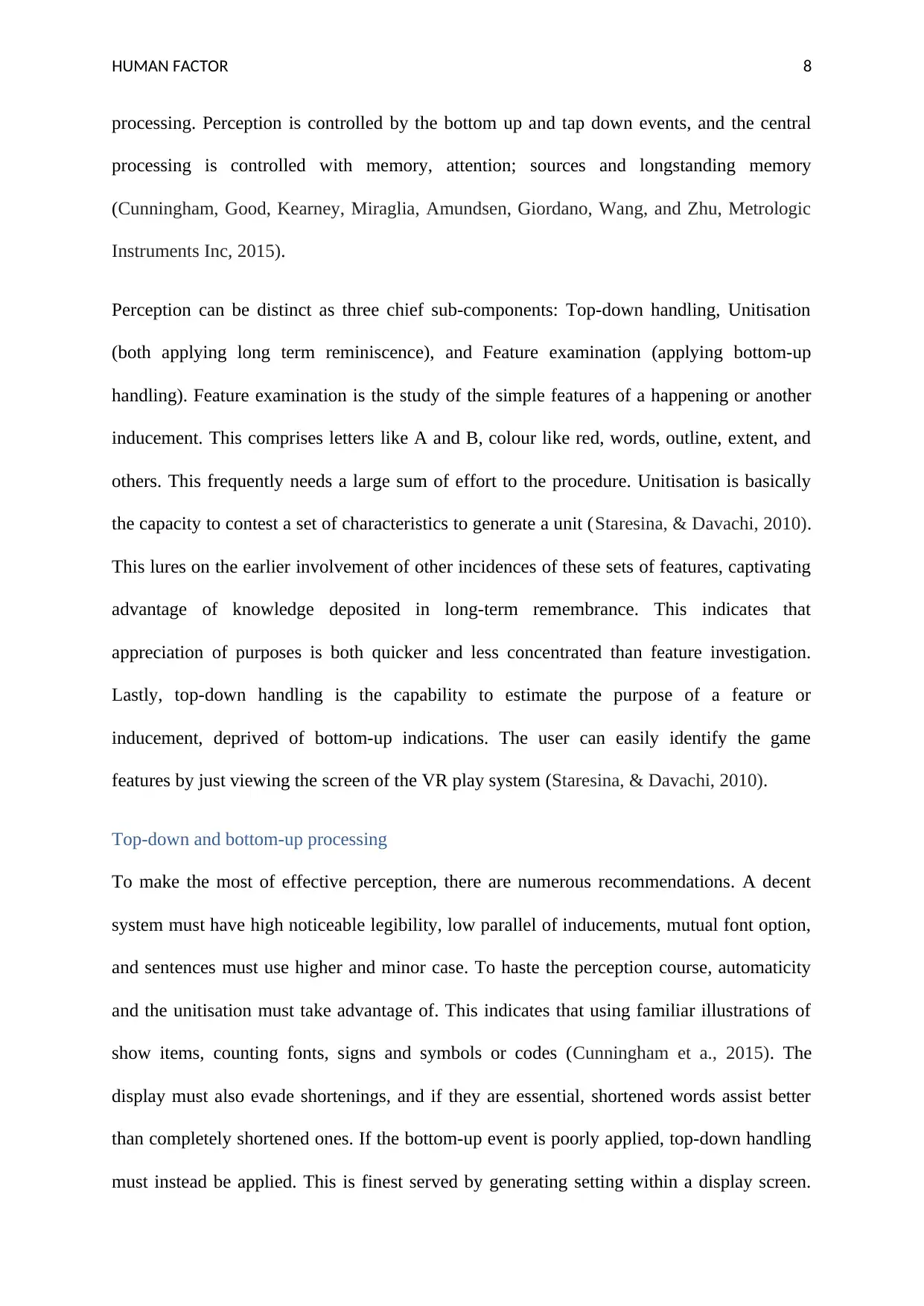
HUMAN FACTOR 8
processing. Perception is controlled by the bottom up and tap down events, and the central
processing is controlled with memory, attention; sources and longstanding memory
(Cunningham, Good, Kearney, Miraglia, Amundsen, Giordano, Wang, and Zhu, Metrologic
Instruments Inc, 2015).
Perception can be distinct as three chief sub-components: Top-down handling, Unitisation
(both applying long term reminiscence), and Feature examination (applying bottom-up
handling). Feature examination is the study of the simple features of a happening or another
inducement. This comprises letters like A and B, colour like red, words, outline, extent, and
others. This frequently needs a large sum of effort to the procedure. Unitisation is basically
the capacity to contest a set of characteristics to generate a unit (Staresina, & Davachi, 2010).
This lures on the earlier involvement of other incidences of these sets of features, captivating
advantage of knowledge deposited in long-term remembrance. This indicates that
appreciation of purposes is both quicker and less concentrated than feature investigation.
Lastly, top-down handling is the capability to estimate the purpose of a feature or
inducement, deprived of bottom-up indications. The user can easily identify the game
features by just viewing the screen of the VR play system (Staresina, & Davachi, 2010).
Top-down and bottom-up processing
To make the most of effective perception, there are numerous recommendations. A decent
system must have high noticeable legibility, low parallel of inducements, mutual font option,
and sentences must use higher and minor case. To haste the perception course, automaticity
and the unitisation must take advantage of. This indicates that using familiar illustrations of
show items, counting fonts, signs and symbols or codes (Cunningham et a., 2015). The
display must also evade shortenings, and if they are essential, shortened words assist better
than completely shortened ones. If the bottom-up event is poorly applied, top-down handling
must instead be applied. This is finest served by generating setting within a display screen.
processing. Perception is controlled by the bottom up and tap down events, and the central
processing is controlled with memory, attention; sources and longstanding memory
(Cunningham, Good, Kearney, Miraglia, Amundsen, Giordano, Wang, and Zhu, Metrologic
Instruments Inc, 2015).
Perception can be distinct as three chief sub-components: Top-down handling, Unitisation
(both applying long term reminiscence), and Feature examination (applying bottom-up
handling). Feature examination is the study of the simple features of a happening or another
inducement. This comprises letters like A and B, colour like red, words, outline, extent, and
others. This frequently needs a large sum of effort to the procedure. Unitisation is basically
the capacity to contest a set of characteristics to generate a unit (Staresina, & Davachi, 2010).
This lures on the earlier involvement of other incidences of these sets of features, captivating
advantage of knowledge deposited in long-term remembrance. This indicates that
appreciation of purposes is both quicker and less concentrated than feature investigation.
Lastly, top-down handling is the capability to estimate the purpose of a feature or
inducement, deprived of bottom-up indications. The user can easily identify the game
features by just viewing the screen of the VR play system (Staresina, & Davachi, 2010).
Top-down and bottom-up processing
To make the most of effective perception, there are numerous recommendations. A decent
system must have high noticeable legibility, low parallel of inducements, mutual font option,
and sentences must use higher and minor case. To haste the perception course, automaticity
and the unitisation must take advantage of. This indicates that using familiar illustrations of
show items, counting fonts, signs and symbols or codes (Cunningham et a., 2015). The
display must also evade shortenings, and if they are essential, shortened words assist better
than completely shortened ones. If the bottom-up event is poorly applied, top-down handling
must instead be applied. This is finest served by generating setting within a display screen.
⊘ This is a preview!⊘
Do you want full access?
Subscribe today to unlock all pages.

Trusted by 1+ million students worldwide
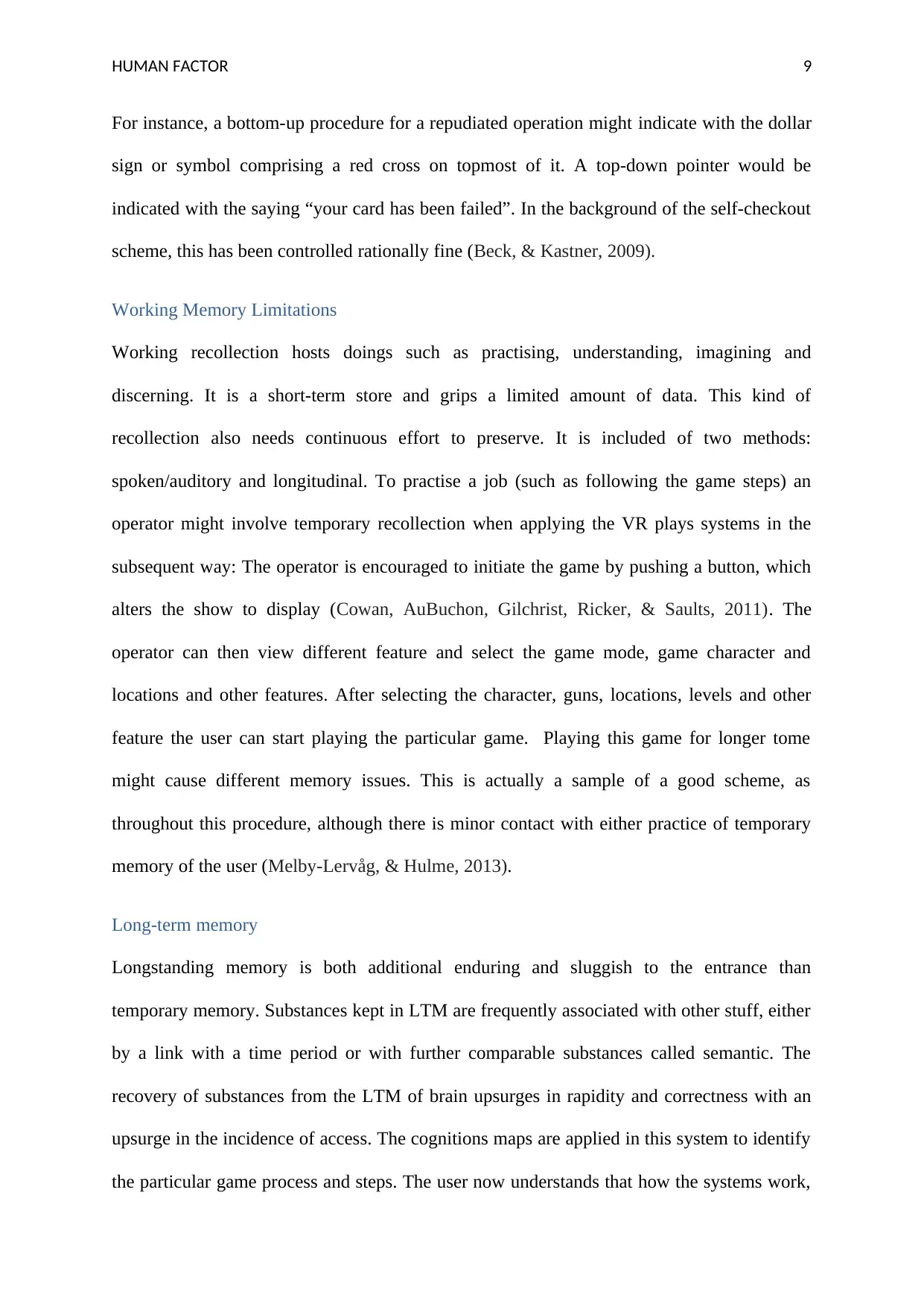
HUMAN FACTOR 9
For instance, a bottom-up procedure for a repudiated operation might indicate with the dollar
sign or symbol comprising a red cross on topmost of it. A top-down pointer would be
indicated with the saying “your card has been failed”. In the background of the self-checkout
scheme, this has been controlled rationally fine (Beck, & Kastner, 2009).
Working Memory Limitations
Working recollection hosts doings such as practising, understanding, imagining and
discerning. It is a short-term store and grips a limited amount of data. This kind of
recollection also needs continuous effort to preserve. It is included of two methods:
spoken/auditory and longitudinal. To practise a job (such as following the game steps) an
operator might involve temporary recollection when applying the VR plays systems in the
subsequent way: The operator is encouraged to initiate the game by pushing a button, which
alters the show to display (Cowan, AuBuchon, Gilchrist, Ricker, & Saults, 2011). The
operator can then view different feature and select the game mode, game character and
locations and other features. After selecting the character, guns, locations, levels and other
feature the user can start playing the particular game. Playing this game for longer tome
might cause different memory issues. This is actually a sample of a good scheme, as
throughout this procedure, although there is minor contact with either practice of temporary
memory of the user (Melby-Lervåg, & Hulme, 2013).
Long-term memory
Longstanding memory is both additional enduring and sluggish to the entrance than
temporary memory. Substances kept in LTM are frequently associated with other stuff, either
by a link with a time period or with further comparable substances called semantic. The
recovery of substances from the LTM of brain upsurges in rapidity and correctness with an
upsurge in the incidence of access. The cognitions maps are applied in this system to identify
the particular game process and steps. The user now understands that how the systems work,
For instance, a bottom-up procedure for a repudiated operation might indicate with the dollar
sign or symbol comprising a red cross on topmost of it. A top-down pointer would be
indicated with the saying “your card has been failed”. In the background of the self-checkout
scheme, this has been controlled rationally fine (Beck, & Kastner, 2009).
Working Memory Limitations
Working recollection hosts doings such as practising, understanding, imagining and
discerning. It is a short-term store and grips a limited amount of data. This kind of
recollection also needs continuous effort to preserve. It is included of two methods:
spoken/auditory and longitudinal. To practise a job (such as following the game steps) an
operator might involve temporary recollection when applying the VR plays systems in the
subsequent way: The operator is encouraged to initiate the game by pushing a button, which
alters the show to display (Cowan, AuBuchon, Gilchrist, Ricker, & Saults, 2011). The
operator can then view different feature and select the game mode, game character and
locations and other features. After selecting the character, guns, locations, levels and other
feature the user can start playing the particular game. Playing this game for longer tome
might cause different memory issues. This is actually a sample of a good scheme, as
throughout this procedure, although there is minor contact with either practice of temporary
memory of the user (Melby-Lervåg, & Hulme, 2013).
Long-term memory
Longstanding memory is both additional enduring and sluggish to the entrance than
temporary memory. Substances kept in LTM are frequently associated with other stuff, either
by a link with a time period or with further comparable substances called semantic. The
recovery of substances from the LTM of brain upsurges in rapidity and correctness with an
upsurge in the incidence of access. The cognitions maps are applied in this system to identify
the particular game process and steps. The user now understands that how the systems work,
Paraphrase This Document
Need a fresh take? Get an instant paraphrase of this document with our AI Paraphraser

HUMAN FACTOR 10
how they can select the features, such as how they control the sound, scripts, display and
other features (Tai, Socher, & Manning, 2015).
Selected and divided attention
Attentional possessions are controlled by salience, energy, probability and worth. These
events filter the partial resources obtainable to temporary memory and assist to direct a
specific order of the criticality for acting out tasks. This particular event is the main trigger
for fault in acknowledgement and remembrance, as definite information has advanced
salience than another type of acts or tasks. Automaticity is the capability of the brain to do
something without thinking too much. It happens with the virtually overlearned behaviours
which come with continues involvement in the system, automaticity allows the user to push
keys and move without taking extra time, it also frees up the recourses (Mares, Palmer, &
Sullivan, 2008).
how they can select the features, such as how they control the sound, scripts, display and
other features (Tai, Socher, & Manning, 2015).
Selected and divided attention
Attentional possessions are controlled by salience, energy, probability and worth. These
events filter the partial resources obtainable to temporary memory and assist to direct a
specific order of the criticality for acting out tasks. This particular event is the main trigger
for fault in acknowledgement and remembrance, as definite information has advanced
salience than another type of acts or tasks. Automaticity is the capability of the brain to do
something without thinking too much. It happens with the virtually overlearned behaviours
which come with continues involvement in the system, automaticity allows the user to push
keys and move without taking extra time, it also frees up the recourses (Mares, Palmer, &
Sullivan, 2008).
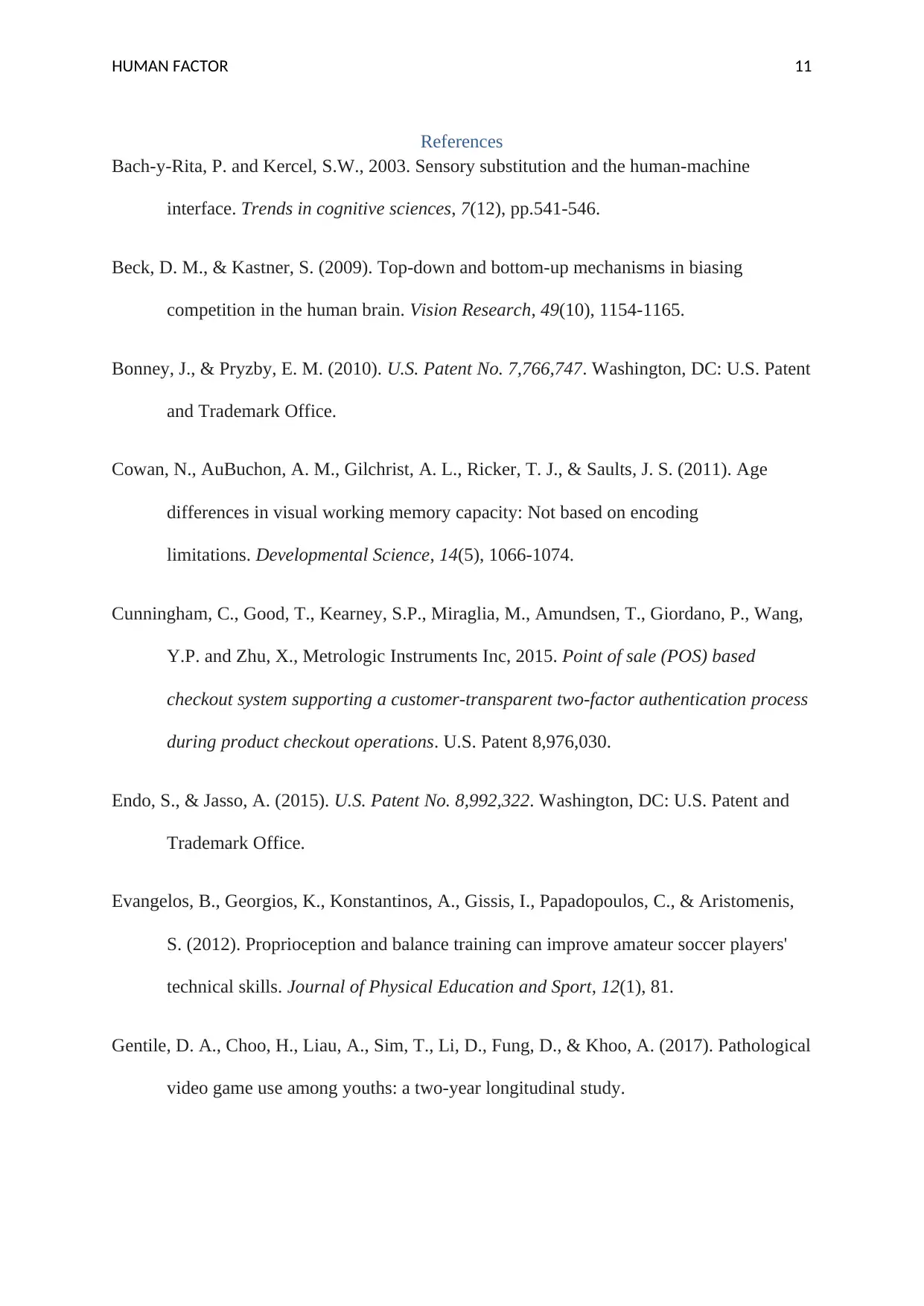
HUMAN FACTOR 11
References
Bach-y-Rita, P. and Kercel, S.W., 2003. Sensory substitution and the human-machine
interface. Trends in cognitive sciences, 7(12), pp.541-546.
Beck, D. M., & Kastner, S. (2009). Top-down and bottom-up mechanisms in biasing
competition in the human brain. Vision Research, 49(10), 1154-1165.
Bonney, J., & Pryzby, E. M. (2010). U.S. Patent No. 7,766,747. Washington, DC: U.S. Patent
and Trademark Office.
Cowan, N., AuBuchon, A. M., Gilchrist, A. L., Ricker, T. J., & Saults, J. S. (2011). Age
differences in visual working memory capacity: Not based on encoding
limitations. Developmental Science, 14(5), 1066-1074.
Cunningham, C., Good, T., Kearney, S.P., Miraglia, M., Amundsen, T., Giordano, P., Wang,
Y.P. and Zhu, X., Metrologic Instruments Inc, 2015. Point of sale (POS) based
checkout system supporting a customer-transparent two-factor authentication process
during product checkout operations. U.S. Patent 8,976,030.
Endo, S., & Jasso, A. (2015). U.S. Patent No. 8,992,322. Washington, DC: U.S. Patent and
Trademark Office.
Evangelos, B., Georgios, K., Konstantinos, A., Gissis, I., Papadopoulos, C., & Aristomenis,
S. (2012). Proprioception and balance training can improve amateur soccer players'
technical skills. Journal of Physical Education and Sport, 12(1), 81.
Gentile, D. A., Choo, H., Liau, A., Sim, T., Li, D., Fung, D., & Khoo, A. (2017). Pathological
video game use among youths: a two-year longitudinal study.
References
Bach-y-Rita, P. and Kercel, S.W., 2003. Sensory substitution and the human-machine
interface. Trends in cognitive sciences, 7(12), pp.541-546.
Beck, D. M., & Kastner, S. (2009). Top-down and bottom-up mechanisms in biasing
competition in the human brain. Vision Research, 49(10), 1154-1165.
Bonney, J., & Pryzby, E. M. (2010). U.S. Patent No. 7,766,747. Washington, DC: U.S. Patent
and Trademark Office.
Cowan, N., AuBuchon, A. M., Gilchrist, A. L., Ricker, T. J., & Saults, J. S. (2011). Age
differences in visual working memory capacity: Not based on encoding
limitations. Developmental Science, 14(5), 1066-1074.
Cunningham, C., Good, T., Kearney, S.P., Miraglia, M., Amundsen, T., Giordano, P., Wang,
Y.P. and Zhu, X., Metrologic Instruments Inc, 2015. Point of sale (POS) based
checkout system supporting a customer-transparent two-factor authentication process
during product checkout operations. U.S. Patent 8,976,030.
Endo, S., & Jasso, A. (2015). U.S. Patent No. 8,992,322. Washington, DC: U.S. Patent and
Trademark Office.
Evangelos, B., Georgios, K., Konstantinos, A., Gissis, I., Papadopoulos, C., & Aristomenis,
S. (2012). Proprioception and balance training can improve amateur soccer players'
technical skills. Journal of Physical Education and Sport, 12(1), 81.
Gentile, D. A., Choo, H., Liau, A., Sim, T., Li, D., Fung, D., & Khoo, A. (2017). Pathological
video game use among youths: a two-year longitudinal study.
⊘ This is a preview!⊘
Do you want full access?
Subscribe today to unlock all pages.

Trusted by 1+ million students worldwide
1 out of 14
Your All-in-One AI-Powered Toolkit for Academic Success.
+13062052269
info@desklib.com
Available 24*7 on WhatsApp / Email
![[object Object]](/_next/static/media/star-bottom.7253800d.svg)
Unlock your academic potential
Copyright © 2020–2025 A2Z Services. All Rights Reserved. Developed and managed by ZUCOL.

